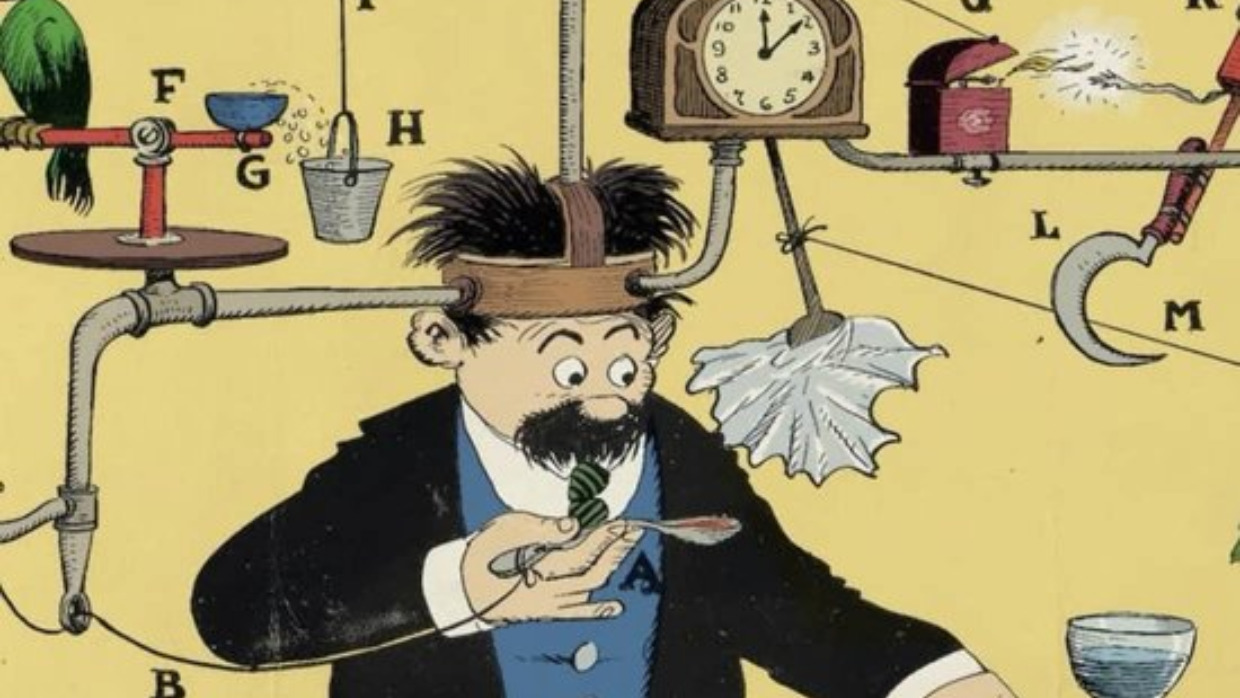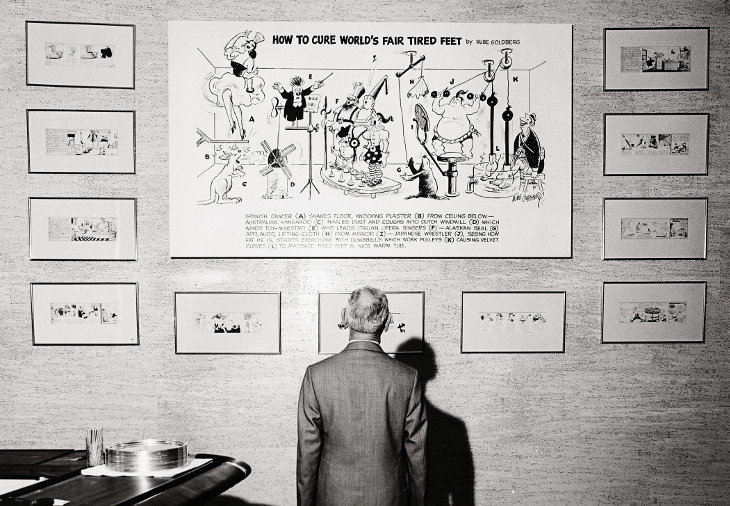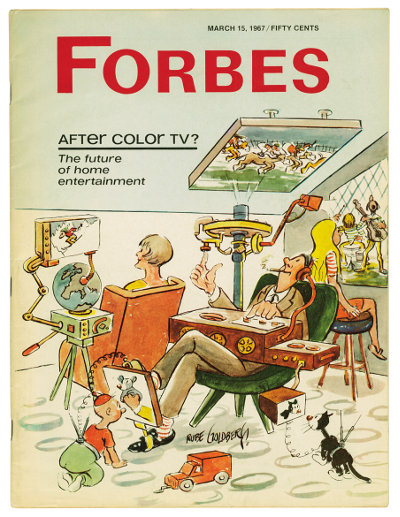 Vampire Weekend's Surprising Jewish Stories
Vampire Weekend's Surprising Jewish Stories


6 min read
Creativity of late cartoonist inspires a new generation.
The Merriam-Webster dictionary defines Rube Goldberg as an adjective: “accomplishing by complex means what seemingly could be done simply.”
The man himself is harder to define.
“The Two Lives of Rube Goldberg,” a new documentary by his youngest grandson, Geoff George, takes up the challenge and is making the rounds of Jewish film festivals.
 Rube Goldberg
Rube Goldberg
Rube Goldberg was a cigar-smoking, bowtie-wearing American cartoonist, humorist, sculptor, author, engineer, thinker, inventor and Pulitzer Prize winner. In a 72-year career, he wrote and illustrated nearly 50,000 cartoons. His images often feature wacky, complicated machines with many moving parts. They perform simple actions one after the next, like a cascade of dominoes.
Think Whoopee Cushion and flyswatter in a machine that makes toast. Or bumblebee, flower and bathtub in an automatic garage door opener.

As granddaughter Jennifer George quips, “All you need is a pile of junk and a great imagination.” The funny thing about Rube was he never made the machines he cooked up in his imagination.
“My grandmother always said he wasn’t very handy around the house. He could barely screw in a lightbulb!”
Born in San Francisco in 1883, Reuben (Rube) was the third of seven children of Max and Hannah Goldberg. Max, an immigrant from Prussia, was a sheriff and worked in banking and real estate. He loomed large in Rube’s life.

Although Rube had been drawing since age 4 and only took formal lessons from a sign painter at age 12, his father discouraged his artistry and sent him to the University of California to train as an engineer.
“He didn’t like it and decided to pursue his true passion, to become a cartoonist,” recounts grandson Geoff. “He had done cartooning for school yearbooks. Little by little, he sold ideas for comics to different newspaper strips.”

Rube moved to The Big Apple in 1907 and started making a name for himself as a cartoonist with the New York Evening Mail, and with a comic strip called “Foolish Questions” beginning in 1908.
Al Jaffee, a 100-year-old fellow cartoonist featured in “The Two Lives of Rube Goldberg,” recalls hanging around the newsstand waiting to buy a paper so he could follow the comic characters.
“It was a different era, but it was wonderful,” Jaffee says in the documentary. “There were no continuing stories on radio and TV, because when I was a child, those things didn’t exist yet. What was going to happen to Little Orphan Annie and to Rube Goldberg’s characters? It was like current news.”

Fortune, fame and family were quick to follow for Rube. By 1915, he had bragging rights as America’s most popular cartoonist and was making $25,000 per year—approximately $700,000 in today’s dollars. Then, rather than lose him to a job offer from William Randolph Hearst’s newspaper chain, the New York Evening Mail doubled Rube’s salary.
Rube married Irma Seeman in 1916 and within a few years became a father to two sons, Thomas and George.
The Goldbergs hobnobbed with the likes of Groucho Marx and George Gershwin.
“Growing up, I didn’t know what a big deal he was. Then doing this documentary, I was able to understand what it was like for someone to be a famous cartoonist in the 1920s and ‘30s,” says Geoff George, 61-year-old producer/director in St. Paul, Minn., and one of Rube’s six grandchildren.
 A Rube Goldberg Machine, by John S. Dykes
A Rube Goldberg Machine, by John S. Dykes
His cousin Jennifer George, 63, in New York, agrees. As a child, she knew her grandfather as Papa Rube, whose cartoons graced the walls of her home. Always the center of attention at family gatherings, he would entertain her with napkins folded up as talking rabbits.
Jennifer now oversees all aspects of her grandfather’s estate, as Chief Creative Officer of the not-for-profit Rube Goldberg Institute for Innovation and Creativity, a reimagined enterprise that her late father, George W. George, founded in 1988. She also authored a book called “The Art of Rube Goldberg.”
“I had to teach myself who he was,” she says. “People called him a genius. Until I took this deep dive into the research, I didn’t know what that meant.”
For the family, living in Rube’s shadow brought its challenges. During World War II, as his two sons were heading off to college, Rube insisted they change their surname to George due to antisemitic sentiment toward him because of his political cartoons. It’s also possible that Rube may not have wanted his offspring to live under the specter of his success.
Rube died in 1970, but his legacy flourishes. He is truly enjoying a second life—a renaissance. His idea for crazy chain-reaction machines has lit up a new generation of fans. Students of all ages in private and public schools, and even home-schoolers, compete in Rube Goldberg Machine Contests® across the world.
Through the Rube Goldberg Institute, family members help manage the competitions. Explains Geoff: “My family runs sanctioned Rube Goldberg Machine Contests®, but there are Rube Goldberg contests all over the place. It’s an educational tool. That’s where his life has really gone, toward education. I think he’d fall off his chair if he could see the impact he’s had.”
For instance, in his Rube documentary, Geoff trains the camera lens on a Shakopee, Minn., middle school with a Rube Goldberg Machine® team. “An amazing thing happened. The minute they started working on this thing, everything changed in that room. There was enthusiasm, creativity, excitement, communication, laughter. Within an hour they created a really good little machine.”
Dr. AnnMarie Thomas, founder and director of the Playful Learning Lab at the University of St. Thomas in St. Paul, Minn., credits Rube with giving children a new way of thinking. The Rube Goldberg Machines® teach on many levels: “We have to embrace that things go wrong. And sometimes they go wrong and you have to fix them or learn from them and try something else. It’s a road trip without a map.”
Rube creates ripples across the culture. For instance, recent ads leading up to the Super Bowl had a Rube Goldberg vibe. On TikTok, #rubegoldberg is trending with half a billion posts.
Observes Jennifer: “He was an adjective in his lifetime. Today he’s a verb: ‘Do you Rube?’”

RUBE Goldberg inventions suggest to me that people can become lazy and habitual. By rigging up some crazy mechanisms, we might be able to overcome some laziness and some habits.
So, in this way, RUBE Goldberg's zany inventions might make some sense, and give us ideas for improvement in our lives. TEFILLIN suggest to me this very idea, in a way. TNX MCH
PHENOMINAL